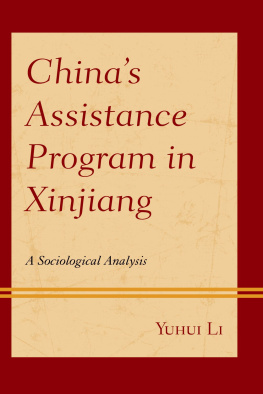Technology Transfer to the USSR, 19281937 and 19661975
Westview Replica Editions
This book is a Westview Replica Edition. The concept of Replica Editions is a response to the crisis in academic and informational publishing. Library budgets for books have been severely curtailed; economic pressures on the university presses and the few private publishing companies primarily interested in scholarly manuscripts have severely limited the capacity of the industry to properly serve the academic and research communities Many manuscripts dealing with important subjects, often representing the highest level of scholarship, are today not economically viable publishing projects. Or, if they are accepted for publication, they are often subject to lead times ranging from one to three years. Scholars are understandably frustrated when they realize that their first-class research cannot be published within a reasonable time frame, if at all.
Westview Replica Editions are our practical solution to the problem. The concept is simple. We accept a manuscript in camera ready form and move it immediately into the production process. The responsibility for textual and copy editing lies with the author or sponsoring organization. If necessary we will advise the author on proper preparation of footnotes and bibliography. We prefer that the manuscript be typed according to our specifications, though it may be acceptable as typed for a dissertation or prepared in some other clearly organized and readable way. The end result is a book produced by lithography and bound in hard covers. Initial edition sizes range from 400 to 600 copies, and a number of recent Replicas are already in second printings. We include among Westview Replica Editions only works of outstanding scholarly quality or of great informational value and we will continue to exercise our usual editorial standards and quality control.
Technology Transfer to the USSR, 19281937 and 19661975: The Role of Western Technology in Soviet Economic Development
George D. Holliday
This analysis of the basic Soviet orientation to the international economy in general, and to Western technology in particular, examines the Soviet experience in borrowing technology from the West during two periods, 19281937 and 19661975. It includes case studies of three major projects in the Soviet automotive industry.
Dr. Holliday studies the methods used by the Soviet Union to acquire foreign technology and evaluates the impact of Soviet attitudes, policies, and economic institutions on the technology transfer process. The evidence he presents--a new Soviet economic growth strategy that places emphasis on technological change, new attitudes among Soviet political leaders, and new institutional developments--suggests that Soviet policy is undergoing a gradual but definitive change away from the isolationist approach of the Stalinist period toward a policy of greater technological interdependence with the West.
George D. Holliday is an analyst in internaltional trade and finance with the Congressional Research Service, Library of Congress.
First published 1979 by Westview Press
Published 2019 by Routledge
52 Vanderbilt Avenue, New York, NY 10017
2 Park Square, Milton Park, Abingdon, Oxon OX14 4RN
Routledge is an imprint of the Taylor & Francis Group, an informa business
Copyright 1979 Taylor & Francis
All rights reserved. No part of this book may be reprinted or reproduced or utilised in any form or by any electronic, mechanical, or other means, now known or hereafter invented, including photocopying and recording, or in any information storage or retrieval system, without permission in writing from the publishers.
Notice:
Product or corporate names may be trademarks or registered trademarks, and are used only for identification and explanation without intent to infringe.
Library of Congress Catalog Card Number: 79-4138
ISBN 13: 978-0-367-28953-9 (hbk)
I wish to acknowledge the assistance of Dr. Charles F. Elliott and Dr. John P. Hardt. Their guidance, encouragement and gentle prodding contributed greatly to the completion of this research.
The Institute for Sino-Soviet Studies and the Graduate Program in Science, Technology, and Public Policy of the George Washington University gave valuable financial assistance.
The final manuscript reflects the diligent and expert typing assistance of Mary Helen Holliday Seal.
I owe a special debt of gratitude to my wife, Marsha, for her moral and intellectual support, for her professional assistance in library matters and for her forbearance. My daughter Lara, who at a very early age learned the importance of silence for scholarly research, also made an important contribution.
Technology Transfer to the USSR, 19281937 and 19661975
1.
Introduction
From the mid-1960s to the mid-1970s the Soviet Union experienced a rapid increase in the scale of its commercial relations with the industrial West. An important component of these relations was the transfer of modern industrial technologies from the West to the Soviet Union. The Soviet experience during this period contrasts with a much lower level of commercial exchanges during the preceding three decades, but is reminiscent of Soviet-Western commercial relations during the First Five-Year Plan (19281932). During the First Five-Year Plan, as during the 1960s and 1970s, Soviet industry was the recipient of large-scale transfers of Western technologies which were critical to Soviet industrial development plans. The resurgence of Soviet commercial relations with the West has generated considerable interest in Soviet policy making in this realm. Western firms are studying this phenomenom in an effort to determine if the Soviet Union is a profitable market for their products. Western governments are interested not only in the prospective economic benefits, but also in the political and national security implications of wider commercial ties to the Soviet Union.
Questions involving technology transfer command a more general interest in the world today. This interest has been sparked largely by a new awareness of the central role of technology in economic growth. The technology gap between advanced industrial countries and the developing countries is widely perceived to be a major cause of the uneven distribution of world production. The borrowing of technology from the more technologically advanced countries appears to be a key to economic development. Technology transfer is also becoming an increasingly important component of trade relations among the advanced industrial nations. While Western-Soviet technological relations are in some ways unique, they appear to be largely an element of the worlds growing technological interdependence.
The purpose of this study is to examine the Soviet experience in borrowing technology from the West during two periods, 19281937 and 19661975. Specifically, this study analyzes the methods used by the Soviet Union to acquire foreign technology and evaluates the impact of Soviet attitudes, policies, and economic institutions on the technology transfer process. Central to the purpose of this study is an analysis of the basic Soviet orientation to the international economy in general and to Western technology in particular. A survey of the Western and Soviet literature on the subject reveals three basic hypotheses about the expansion of Soviet commercial and technological ties to the West since the mid-1960s. The first hypothesis stresses the Soviet quest for autarky or economic self-sufficiency in its commercial relations with the West:







